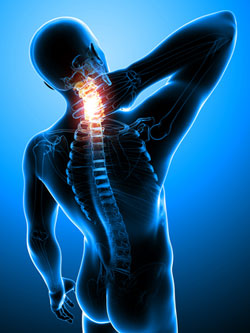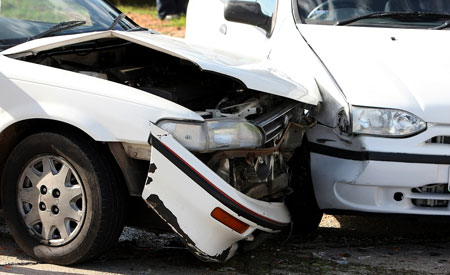Car Accident Treatment
Chiropractic Treatments for Whiplash
Because each individual case of whiplash is different, it is not possible to generalize about the chiropractic whiplash treatment.
The appropriate chiropractic treatment is unique to each whiplash injury and is directed at the primary dysfunctions detected during the chiropractic exam and history, which includes the mechanisms of injury and ordering of imaging (X-ray, MRI) if needed.
However, we commonly employ different chiropractic treatments for whiplash, often including:
- Manipulation
- Massage Therapy
- Moist Heat/Ice
- Muscle Stimulation
- Rehabilitation Exercises
- Ergonomic and Lifestyle Changes
Chiropractic Treatment Approach to Whiplash Injuries
The chiropractor’s general approach to managing the patient’s chiropractic care is critical to the success of preventing chronic pain from whiplash injuries.
- In the early stages of management, it is very important for the chiropractor to rapidly reduce the patient’s neck pain, back pain and/or other symptoms.
- Soon after, the chiropractor’s whiplash treatment must be shifted toward restoration of the patient’s function. This means helping the patient return to work, home and recreational activities as soon as possible after sustaining the whiplash injuries. This process may involve a gradual transition to these activities, even if the patient is not sure that he or she can engage in them fully.
Chiropractic Manipulation for Whiplash
The primary whiplash treatment for joint dysfunction, spinal manipulation involves the chiropractor gently moving the involved joint into the direction in which it is restricted.
Also known as a chiropractic adjustment, spinal manipulation may involve the application of a short thrust in that direction. In many cases, instead of a thrust, a slow mobilizing movement is used by the chiropractor.
Muscle Relaxation or Stimulation as Whiplash Treatments
The chiropractor’s primary whiplash treatment for related muscle dysfunction, muscle relaxation and/or stimulation consist of gentle stretches to the muscle that has excessive tension or repeated contractions of the muscle that is inhibited.
If the muscle is very tight, a more vigorous stretch may be applied by the chiropractor. Gentle finger pressure techniques may be applied to trigger points to relieve the pain associated with the tight muscles.
Electrical Muscle Stimulation is often used to help relax the muscles involved. This therapy generally is very comfortable and helps with healing of soft tissue injuries.
Massage Therapy for Whiplash
In our clinic, we often have massage therapy prescribed for treatment on a frequent basis to aid in the healing of the soft-tissue injuries. This treatment is done in our office by Certified Massage Therapists and treatment is focused on areas of injury.
McKenzie Exercises and Stabilization/Sensorimotor Activities
Chiropractors may employ different types of exercises, including McKenzie exercises and/or stabilization and sensorimotor exercises, to help treat patients with whiplash injuries.
McKenzie exercises are specifically designed to reduce disc derangement related to a whiplash injury. They consist of simple movements that are initially done in the office but make for an easy transition to self-care at home. McKenzie exercises also help the patient take an active role in his or her own recovery.
Stabilization and sensorimotor exercise approaches are designed to correct faulty movement patterns in routine activities and everyday life. Such whiplash treatment trains the nervous system to better coordinate and control movement patterns, and improves the ability of the neck muscles to maintain stability of the neck.
These exercises are designed to help in a major trauma, such as a fall or whiplash during a motor vehicle accident, or in “micro trauma”from simple things such as being jostled in a crowd, playing sports, or performing occupational or home jobs that require physical effort.
Chiropractic Advice on Ergonomic and Lifestyle Changes
These whiplash treatment suggestions stress improvements for performing everyday activities with minimal strain to the body. The chiropractic advice addresses factors in an individual’s work, home or recreational activities that perpetuate the dysfunctions that result from the whiplash accident.
Additionally, spine care professionals at the chiropractic clinic may teach the patient better “use of self” and, if necessary, stress reduction methods to help chiropractic problems.
Whiplash Treatment in Chiropractic Care
The whiplash treatment plan developed by the chiropractor for each specific problem may include one or more of these approaches and may involve others as well.
In addition to his or her whiplash treatment plan, the doctor of chiropractic might give a referral to another health professional, such as a medical specialist, if it is deemed appropriate.
Preventing Chronic Pain from Whiplash
After sustaining whiplash injuries, it is fairly common for people to suffer from chronic neck pain, if left untreated. A chiropractor can detect certain factors in a patient’s history and chiropractic exam to better determine patients who may be more susceptible to chronic pain from a whiplash injury .
This process will help the doctor of chiropractic identify when aggressive preventative measures should be taken for patients who may be at a greater risk of developing chronic neck pain from whiplash injuries.
- Restoring confidence after a whiplash injury, on the part of the patient, in his or her ability to get back to normal activity levels is also important for rehabilitation.
- Exercise, both for the purpose of correcting faulty movement patterns and instability, and for general fitness, is important in this effort to treat whiplash injuries.
Teaching the patient the nature of chronic pain (that “hurt does not necessarily mean harm”) and placing focus on those activities the patient can do, rather than those he or she cannot, are major parts of chronic pain and disability prevention after whiplash injuries.
Chiropractors integrate the strategies explained above to develop the most effective approach for recovering from a whiplash injury and preventing future episodes of back pain.

WHIPLASH INJURY INFORMATION
What Is Whiplash?
Whiplash is a term that describes injury to the neck that occurs as a result of a motor vehicle or car accident. The most common type of car accident is the rear impact, and most typically, the occupant in the vehicle that gets “rear-ended” (hit from behind) is at the greatest risk of injury, including whiplash.
What Is Now Known about Whiplash
Until recently, the reason for the extent of whiplash injuries was poorly understood. In addition, due to the legal and insurance issues, the veracity of complaints of neck pain and other symptoms by people who suffer from whiplash is commonly viewed as suspect.
However, recent research has helped clarify why occupants struck from behind experience more extensive whiplash injuries than those in other types of crashes. This new information is important for the physician treating whiplash pain, as it impacts the physician’s case management strategy.
Related Whiplash Symptoms/Conditions
Whiplash injuries can be quite complex and may include a variety of related problems, such as:
- Joint dysfunction. As a result of the whiplash, one of the joints in the spine or limbs may lose its normal resiliency and shock absorption (referred to as the joint play), possibly leading to restricted range of movement and pain.
- Disc herniation. A whiplash accident may injure the discs between the vertebrae, lead to small tears and cause the inner core of the disc to extrude through its outer core. If the disc’s inner core comes in contact with and irritates a nearby spinal nerve root, a herniated disc occurs, with symptoms possibly including sharp, shooting pain down the arm and even neurological symptoms like numbness, tingling and muscle weakness.
- Faulty movement patterns. It is believed that the nervous system may change the way in which it controls the coordinated function of muscles as a result of a barrage of intense pain signals from the whiplash injury.
- Chronic pain. While often resulting in minor muscle sprains and strains that heal with time, more severe whiplash injuries may produce neck pain and other symptoms that are persistent and long-lasting (chronic).
- Cognitive and higher center dysfunction. In some instances,whiplash may affect the patient’s mental functioning, possibly leading to difficulties concentrating, as just one example.
How Does Whiplash Occur?
A whiplash accident occurs when one motor vehicle strikes another, typically from behind, causing certain forces to be transmitted from the striking vehicle to the struck vehicle. These forces are then transmitted to the occupant(s) of the struck vehicle, where they have the potential to cause whiplash injury.
Research Findings on Whiplash Accidents
Research both in the Biomechanics Laboratory at Yale University in New Haven and in live crash tests using human volunteers has shed relatively new light on the contortions the cervical spine (neck) undergoes as a result of impact culminating in whiplash.
Shortly after impact (about 150 milliseconds), the cervical spine undergoes what is called an S-shaped curve. In this configuration, the cervical spine,rather than simply being curved to the front in a normal C-shape, as it would normally be at rest, takes on an altered shape:
- The lower part of the cervical spine moves into extension (bent backward)
- The upper part of the cervical spine moves into flexion (bent forward).
When a whiplash accident occurs, the lower part of the cervical spine moves well beyond its normal range of motion, causing the potential for injury to the ligaments and discs in that area. The upper part of the cervical spine also moves beyond its normal range of motion, but to a lesser extent.
Cervical Spine Reactions to a Whiplash Accident
There is an inherent stabilization response in the cervical spine that helps protect it from potential whiplash injury:
- The nervous system detects the presence of the impact
- The muscles of the cervical spine, under the direction of the nervous system, contract quickly to try to minimize the effects of the impact on the ligaments and discs.
If this stabilization response is working efficiently following the whiplash accident, there is a greater likelihood of protection and less potential for whiplash injury. But if the response is inefficient, an injury is more likely, with various types of whiplash pain possibly resulting and whiplash treatment potentially necessary.
Factors Affecting the Whiplash Injury
There are several factors that affect the efficiency of the stabilization response to whiplash injury, including:
- Posture at impact
- Overall physical condition
- Awareness of coming impact
- Gender
- Others
It should be known that some of these stabilization responses to whiplash are within the patient’s capacity to control while others are not.
Postural Impact on Whiplash Injury
The posture in which a person is sitting at the moment of impact helps determine the efficiency of the stabilization response that will affect the severity of the whiplash injury.
Sitting in a correct posture promotes an efficient stabilization response. Sitting in a poor posture, particularly a “slumped” type posture, promotes an inefficient stabilization response.
Overall Physical Condition and Whiplash Injuries
The better conditioned the body is in general, the more efficient the stabilization response will be. This particularly relates to the condition of the nervous system, as a well-functioning nervous system is essential to a proper stabilization response.
Awareness of Coming Impact on Whiplash Injury Severity
Perhaps the most important factor that affects the efficacy of the stabilization response in relation to whiplash injuries is awareness of the impending impact.
Scenario 1: Aware of impending impact. This person is able to automatically prepare the stabilization system to respond quickly and efficiently.
Scenario 2: Unaware of the impending impact. This person cannot prepare the stabilization system, thus slowing the response and decreasing its efficiency. This person is likely to sustain greater whiplash injury than is the person who is aware.
This may help explain the findings of some studies that have shown a passenger in a struck vehicle is likely to sustain greater whiplash injury than the driver. The driver is more likely to see the vehicle coming in the rear view mirror.
Whiplash Injuries and Gender
Women in general are more frequently and more seriously injured by whiplash than men due to the differences in muscular bulk and the female’s smaller bony structures. These factors result in less protection of the cervical spine to the abnormal forces such as those that occur in a whiplash-type of injury.
Other Factors Affecting Whiplash Injury
Risk factors influencing prognosis of a whiplash injury include:
- Whiplash pain /symptoms persisting beyond 6 months
- Significant ligament, disc,nerve, or joint capsule injury
- Delay in initiating treatment
- Need to resume treatment for more than one flare-up of pain
- Occupant age over 65
- Head restraint more than 2″ away from occupant’s head
- Occupant in a small car
- Alcohol intoxication at time of automobile accident
- Pre-existing x-ray evidence of degenerative changes
- Prior whiplash injury
- Prior cervical spine fusion
- Patient having initial radicular (arm pain, numbness, tingling) symptoms
- A cervical collar used for more than 2 weeks.
Common Misconception about Whiplash Injury
A common misconception about whiplash injury is that if the vehicle does not sustain damage in a low speed impact, then whiplash injury to the occupant does not occur.
In reality, low impact collisions can produce correspondingly higher dynamic loading on the occupants because the lack of crushing metal to absorb the forces results in a greater force applied to items or occupants within the vehicle.
Sources of Whiplash Pain
When the cervical spine (neck) is subject to whiplash, there is usually a combination of factors that contribute to whiplash pain in the neck and back, and ultimately need to be addressed individually by a chiropractor.
The doctor of chiropractic maintains a “holistic” view of the patient’s whiplash pain, specifically focusing on one or more of the following:
- Joint dysfunction
- Muscle dysfunction
- Faulty movement patterns
- Disc derangement
Whiplash Pain Management for Joint Dysfunction
Joint dysfunction from whiplash occurs when one of the joints in the spine or limbs loses its normal joint play (resiliency and shock absorption). It is detected through motion palpation, a chiropractic technique in which the chiropractor gently moves the joint in different directions and assesses its joint play. When a joint develops dysfunction, its normal range of movement may be affected and it can become painful.
Additionally, joint dysfunction can lead to muscle imbalance and pain,and a vicious cycle:
- The loss of joint play can cause abnormal signals to the nervous system (there are an abundance of nerve receptors in the joint)
- The muscles related to that joint can subsequently become tense or, conversely, underactive
- The resulting muscle imbalance can place increased stress on the joint, aggravating the joint dysfunction that already exists.
Muscle Dysfunction from Whiplash Injuries
When joint dysfunction develops, muscles are affected. Some muscles respond by becoming tense and overactive, while others respond by becoming inhibited and underactive. In either case, these muscles can develop trigger points that may necessitate whiplash treatment involving muscle relaxation or stimulation.
Trigger points are areas of congestion within the muscle where toxins accumulate. These toxins can irritate the nerve endings within the muscle and produce pain. This whiplash pain can occur in the muscle itself or can be expressed as referred pain (perceived in other areas of the body).
The muscle can also send abnormal neurological signals into the nervous system, which can then cause disruption of the ability of the nervous system to properly regulate muscles in other parts of the body, leading to the development of faulty movement patterns.
Faulty Movement Patterns and Whiplash Pain
It is thought that the intense barrage of pain signals from a traumatic whiplash injury to the cervical spine can change the way the nervous system controls the coordinated function of muscles. The disruption of coordinated, stable movement is known as faulty movement patterns.
Faulty movement patterns can cause increased strain in the muscles and joints, leading to neck pain and back pain. They can involve the neck itself or can arise from dysfunction in other areas of the body such as the foot or pelvis.
Instability is also considered part of faulty movement patterns. There are 2 types of instability that can occur in whiplash:
- Passive instability-the ligaments of the neck are loosened, making it more susceptible to whiplash pain.
- Dynamic instability-the nervous system disruption causes a disturbance in the body’s natural muscular response to common, everyday forces.
As a result of instability, even mild, innocuous activities can be difficult to perform as they often exacerbate the whiplash pain.
Whiplash Pain from a Herniated Disc
The force of whiplash can cause injury to the discs between the vertebrae, and small tears can develop. If the gelatinous middle of the disc seeps out, it can irritate the nerve endings in this area. This is known as disc derangement.
Occasionally, the gel can seep all the way out and press on a nerve root exiting the spinal cord behind the disc, known as disc herniation.
A herniated disc may involve whiplash pain in the neck as well as sharp, shooting pain down the arm and possibly neurological symptoms such as numbness, tingling and muscle weakness.

Medical Expenses & Car Insurance
Medical expenses resulting from an auto accident are covered under liability bodily injury insurance, personal injury protection (PIP), and medical payments (MedPay). Depending on your state, you may be required to carry either liability or PIP/MedPay.
Know What Your Car Insurance Policy Covers
When it comes to medical coverage on your auto insurance policy, it’s in your best interest to be absolute certain of what it specifically covers. We can help you with calling on your policy to determine exactly what is covered. We will always provide free consultations to answer any questions you have about insurance coverage and treatment options.
General Types of Auto Insurance Coverage
Liability Bodily Injury Protection
Currently almost every state requires all motorists to carry varying amounts of liability protection or prove financial responsibility in some other way (generally, by posting a surety bond of some sort).
However, a liability policy is the most common, and this policy covers the medical bills-up to the designated insurance limits-of motorists and/or pedestrians injured due to your driving negligence.
Personal Injury Protection (PIP)
Personal injury protection, or what many refer to as no-fault insurance, will cover your medical costs regardless of fault. Even if you’re the one who caused the accident by running a red light, you and your passengers will be covered up to the limits on your PIP policy.
In addition to medical costs, PIP also covers:
- Lost wages
- Funeral expenses
- Child care
- Household maintenance
Currently PIP is only required in some states. If you reside in a tort state (one that requires liability insurance), you may be able to carry PIP as an option, in addition to your liability coverage.
Medical Payment (MedPay)
MedPay, like PIP, is commonly referred to as no-fault insurance. In the states requiring no-fault coverage (see listings above in PIP section) you’re usually given the option of carrying either MedPay or PIP.
MedPay, compared to PIP, is more limited. It only covers medical costs and funeral expenses, and, unlike other forms of coverage, when you file a MedPay car accident injury claim, you’ll be required to pay for all medical costs up front, out of your own pocket. To be compensated, you’ll then need to supply your provider with your hospital and/or medical receipts.
Even if MedPay is not required in your state, it’s always a wise insurance option to own, especially if you carry little or no health insurance.

Sign up for our Newsletter
Get the latest news and information from us when you sign up for our newsletter.







